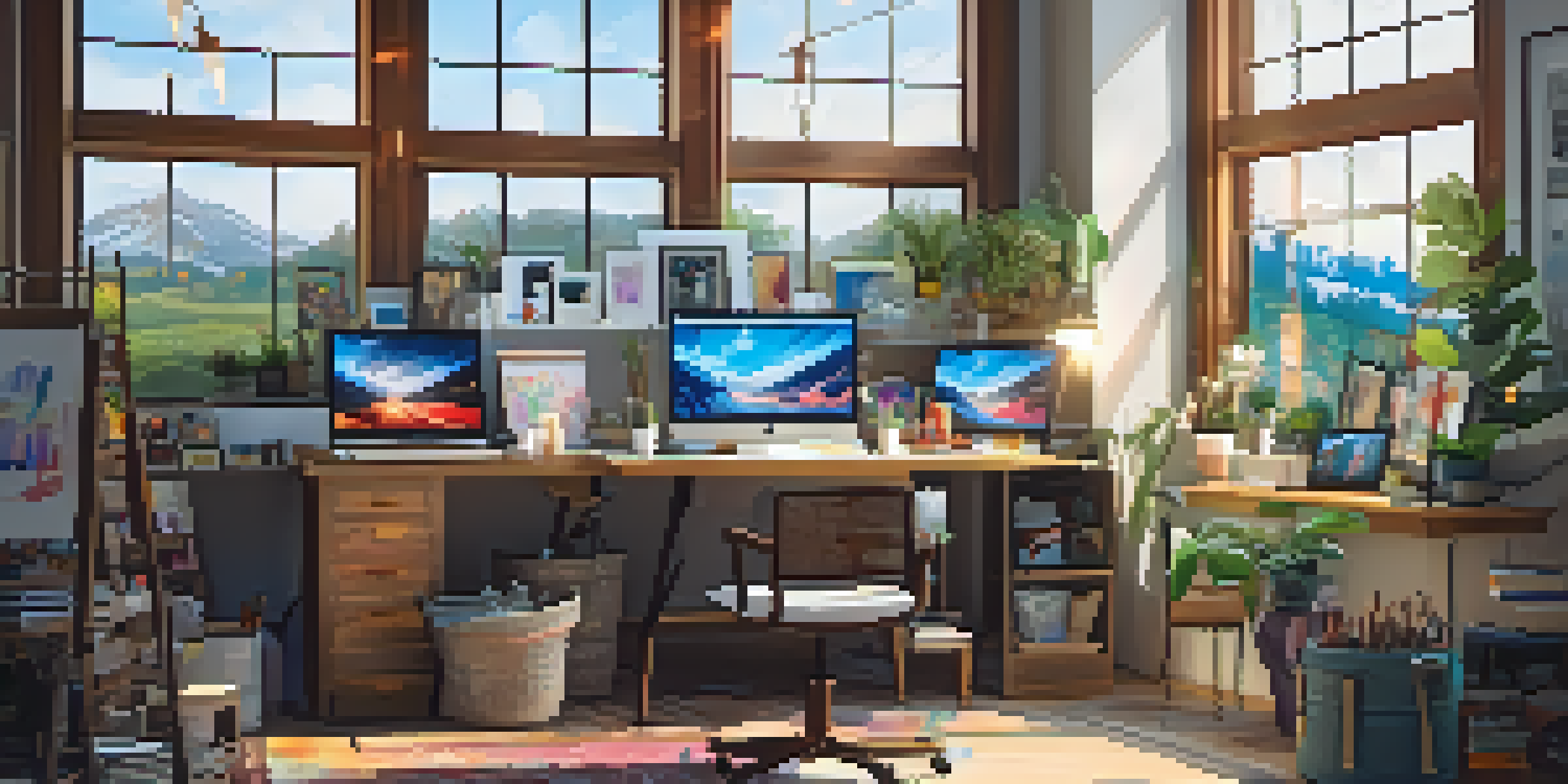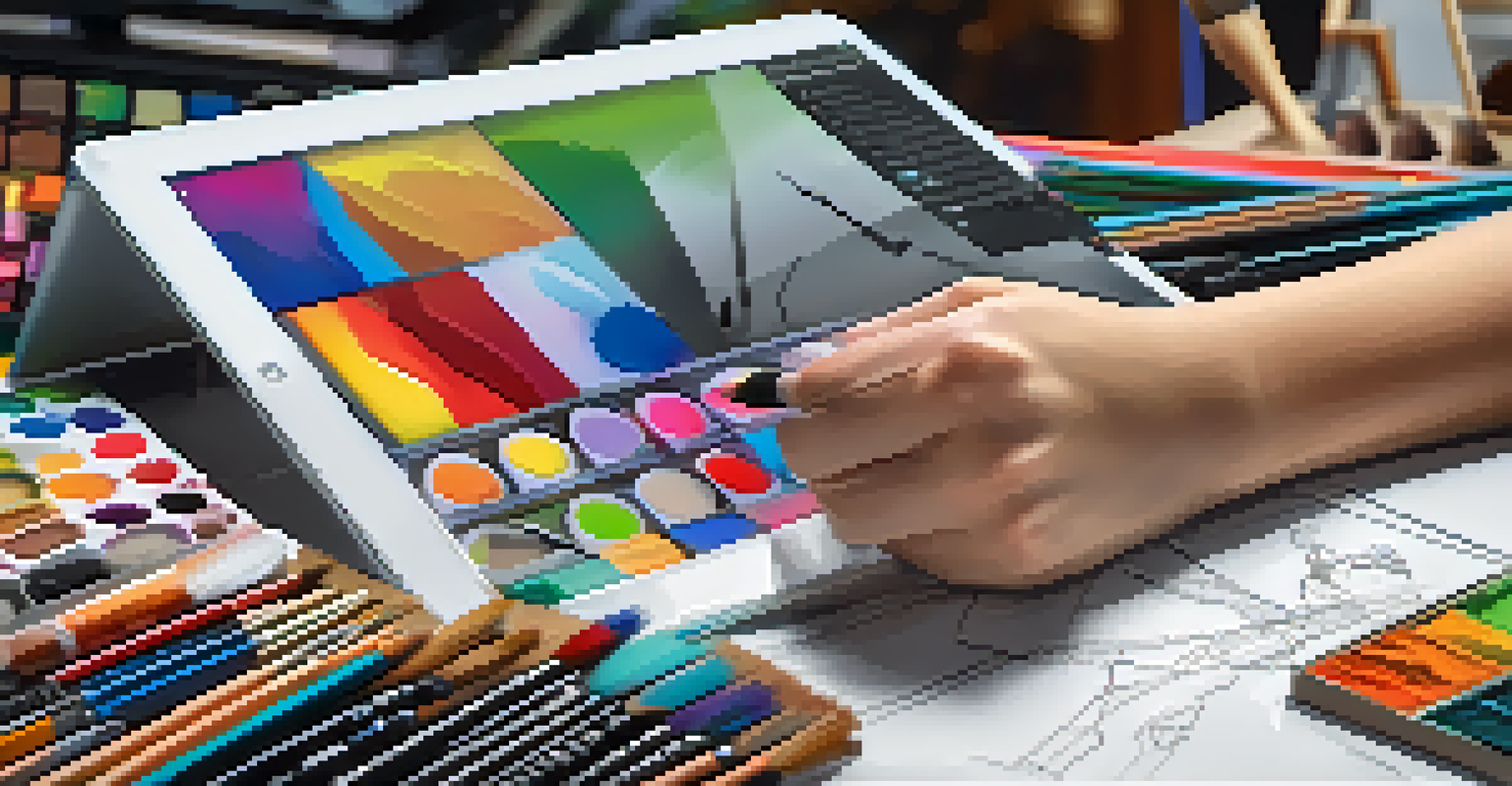Social Media Art: New Platforms for Identity Expression

The Rise of Social Media as an Art Platform
Social media has revolutionized how we create and share art. Artists no longer rely solely on galleries to showcase their work; platforms like Instagram and TikTok serve as vibrant galleries for digital art. This shift has democratized access to art, allowing anyone with a smartphone to display their creativity to a global audience.
Art is not freedom from discipline, but disciplined freedom.
Moreover, these platforms empower artists to connect directly with their audience, fostering a sense of community and engagement. For instance, hashtag movements can unite artists around a common theme, sparking collaboration and inspiration. As a result, social media becomes not just a showcase but a dynamic environment for artistic expression.
In this digital age, the lines between artist and audience blur, making art more accessible and interactive. Artists can receive real-time feedback, adjust their work, and even collaborate with fans, creating a unique ecosystem that thrives on participation and innovation.
Identity and Self-Expression Through Digital Art
Social media platforms provide a unique canvas for exploring and expressing personal identity. Artists often use their work to reflect their experiences and perspectives, allowing them to share their stories with the world. This authentic self-expression can resonate with others, fostering connections that transcend geographical boundaries.

For example, many LGBTQ+ artists utilize platforms like TikTok to share their journeys, creating art that challenges societal norms and promotes acceptance. This not only empowers the artists but also provides a sense of belonging for viewers who see themselves reflected in the work. Such expressions can spark dialogue and promote understanding across diverse communities.
Social Media Empowers Artists
Platforms like Instagram and TikTok allow artists to showcase their work directly to a global audience, fostering community and collaboration.
Furthermore, digital art allows for experimentation with various styles, mediums, and narratives, enabling artists to explore different facets of their identities. The freedom to create without the constraints of traditional art forms encourages individuals to push boundaries and redefine what art means to them.
The Role of Aesthetics in Digital Identity
Aesthetics play a significant role in how we curate our digital identities on social media. The visual elements of an artist's profile—colors, fonts, and layout—contribute to the overall impression they make on viewers. As a result, artists often spend considerable time crafting their online presence to reflect their unique style and personality.
Creativity takes courage.
For instance, an artist whose work focuses on nature may choose earthy tones and organic shapes to create a cohesive aesthetic that resonates with their art. This intentional curation can enhance their brand identity, making it easier for followers to connect with their work on a deeper level. It's like creating a visual signature that speaks volumes about who they are as artists.
Moreover, this emphasis on aesthetics influences how audiences perceive and interact with art. A striking visual presentation can draw viewers in, encouraging them to engage with the content and share it within their networks, thereby amplifying the artist's reach and impact.
Community Building and Collaboration in Art
Social media has transformed the way artists build communities and collaborate. Artists can now connect with peers, fans, and even potential mentors from around the world, fostering a sense of belonging and support. This communal aspect is particularly valuable for emerging artists seeking guidance and exposure.
Collaborative projects—like collective art challenges or themed exhibitions—can arise organically on platforms like Instagram. These initiatives not only showcase diverse talents but also encourage cross-cultural exchanges, enriching the artistic landscape. Such collaborations can lead to innovative art forms and a shared sense of purpose among participants.
Authenticity vs. Online Persona
The pressure to maintain a polished online presence can challenge artists' authenticity, leading them to navigate the balance between self-expression and audience expectations.
Furthermore, community engagement often extends beyond mere collaboration; it involves supporting one another through likes, shares, and constructive feedback. This culture of encouragement helps cultivate a vibrant ecosystem where creativity flourishes, proving that art is not only about individual expression but also about shared experiences.
Challenges of Authenticity in Digital Art
While social media offers incredible opportunities for expression, it also raises questions about authenticity. The pressure to curate a perfect online persona can lead some artists to compromise their true selves for likes and followers. This creates a dilemma: how do you remain authentic in a landscape that often rewards polished perfection?
Many artists grapple with the tension between self-expression and audience expectations. For instance, an artist may feel compelled to create work that aligns with trending aesthetics rather than exploring their unique style. This struggle can dilute the authenticity that makes art relatable and powerful.
To combat this, some artists emphasize the importance of vulnerability in their work. By sharing the messy, imperfect aspects of their creative journeys, they invite their audience to embrace authenticity. This approach not only fosters deeper connections but also encourages others to express themselves genuinely, regardless of societal pressures.
The Impact of Algorithms on Artistic Visibility
Algorithms play a crucial role in determining which art gets seen on social media. These complex systems analyze user behavior and engagement to curate content, often favoring posts that generate high interaction rates. As a result, artists must navigate these algorithms to ensure their work reaches a broader audience.
This reliance on algorithms can create a frustrating cycle where artists feel pressured to conform to trends to gain visibility. The challenge lies in balancing authentic self-expression with the need for reach—essentially choosing between staying true to one’s vision and playing the algorithm game.
Algorithms Shape Art Visibility
Algorithms determine which art is seen on social media, compelling artists to adapt their strategies to enhance visibility while staying true to their creative vision.
However, savvy artists are finding ways to work within this framework. By creating engaging content that resonates with their audience, such as behind-the-scenes processes or tutorials, they can increase their visibility while remaining authentic. This adaptability highlights the evolving relationship between art and technology in the digital age.
Future of Social Media Art and Identity Expression
As social media continues to evolve, so too will the ways we express our identities through art. Emerging technologies, such as augmented reality and virtual reality, offer exciting possibilities for interactive and immersive artistic experiences. This shift could redefine how artists engage with their audiences, blurring the lines between creator and viewer even further.
Additionally, as new platforms emerge, artists will have even more avenues for self-expression and connection. The rise of niche communities on platforms like Discord or specialized art networks allows for deeper engagement with specific audiences, fostering unique artistic dialogues. This diversification can lead to richer, more varied expressions of identity.

Ultimately, the future of social media art is not just about technology; it’s about the human experience. As artists continue to explore their identities and share their journeys, social media will remain a powerful tool for connection, creativity, and community, paving the way for future generations of artists.